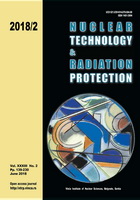
RETROSPECTIVE RADON MEASUREMENTS BASED ON IMPLANTED 210Po IN GLASS OBJECTS USING POLYCARBONATE DETECTORS

Vol.
XXXIII, No. 2, Pp. 139-230
June 2018
UDC 621.039+614.876:504.06
ISSN 1451-3994
Pages: 167-173
Authors: Alireza Azadbar, Dariush Sardari, Mohamadreza Kardan, and Samaneh BaradaranAbstract
In the present investigation, a surface-deposited polonium was measured in 37 houses in Rasht and Ramsar cities of Iran with the aim of evaluating the retrospective radon concentration. The CR-LR technique is widely used in this regard, but for the first time, Lexan polycarbonate detectors were used to measure the activity of 210Po planted in glassy objects. These detectors were placed on glassy surfaces for 153 to 365 days. A passive cylindrical diffusion chamber was used for the contemporary radon concentration measurements. The diffusion chamber consists of the Lexan polycarbonate films as a solid state nuclear track detectors and filter. The surface-deposited 210Po activity concentration was found to vary from 0.26 to 11.96 mBqcm-2 with average of 2.62 mBqcm-2. The sensitivity of 210Po to polycarbonate was determined to be 0.06456 track per cm2 per mBqhcm-2. Thus, the radon concentration was found to vary from 122 to 4840 Bqm-3 with an average value 1243 Bqm-3 and the contemporary radon concentration in the area was found to vary from 15 to 2420 Bqm-3 with an average 513 Bqm-3. The results indicate that there is a significant correlation between the concentration of the retrospective radon and the concentration of the contemporary radon gas in the indicated areas with a coefficient of 0.80672.
Key words: glassy object, retrospective measurement, polonium 210, polycarbonate detector, radon
FULL PAPER IN PDF FORMAT (442 KB)